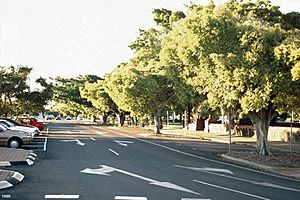Bourbong Street Weeping Figs facts for kids
Quick facts for kids Bourbong Street Weeping Figs |
|
|---|---|

Bourbong Street Weeping Figs, 1999
|
|
| Location | Bourbong Street, Bundaberg Central, Bundaberg, Bundaberg Region, Queensland, Australia |
| Official name: Bourbong Street Weeping Figs | |
| Type | state heritage (landscape) |
| Designated | 23 July 1999 |
| Reference no. | 602065 |
| Significant period | 1888 (historical) |
| Lua error in Module:Location_map at line 420: attempt to index field 'wikibase' (a nil value). | |
The Bourbong Street Weeping Figs are a special group of trees in Bundaberg Central, Queensland, Australia. These large, old trees are found along Bourbong Street. They are important because of their history and how they make the street look. They were added to the Queensland Heritage Register in 1999, which means they are protected because of their historical value.
Contents
A Look Back at the Weeping Figs
The Bourbong Street Weeping Figs are four big Ficus benjamina trees. They were first planted in 1888 in the middle of the road. This was between Barolin and Maryborough Streets. More trees were planted by the Bundaberg City Council in the 1920s.
Bundaberg's Early Days
Bundaberg started as a town on the Burnett River. It became a busy center for farming and mining. In the 1880s, the sugar industry grew a lot. Big sugar refineries like Millaquin, Fairymead, and Bingera were built. This helped the town become very successful.
Why Plant Trees in the City?
As Bundaberg grew, people wanted to make the town look nicer. Planting trees made the streets more beautiful and important. Trees also gave much-needed shade in the main business areas. People also thought trees helped clean the air. Weeping figs were a popular choice because they have thick leaves and wide branches. When planted close together, they created a long, shady path.
Planting trees in the middle of the street was a smart idea. It stopped the tree roots from bothering building foundations. Bourbong Street was made wide enough for two-way traffic and trees in the middle.
Frederic Buss's Gift
The Bundaberg City Council did not always plant trees regularly. But in 1888, a local businessman named Frederic Buss helped out. He gave money to plant trees, build fences, and prepare the ground. Trees were planted in Bourbong, Barolin, Maryborough, and Woongarra Streets. In the early 1920s, more of the same type of trees were added to Bourbong Street.
Frederic William Buss (1845-1926) came to Queensland from England. He started a department store in Bundaberg in 1888. He also became important in the sugar industry. Buss was active in local government and helped the town grow.
Changes Over Time
Over the years, more cars used the roads instead of horses. This led to fewer trees along the street. The four trees between Barolin and Maryborough streets are the only ones left from the original plan. Recently, these trees have been struggling. The open ground around them has become smaller. This means they don't get enough water. New building work in the city center has also made their growing space even smaller.
What the Weeping Figs Look Like
The Bourbong Street Weeping Figs are four large Ficus benjamina trees. They are planted in the middle of the road in Bundaberg. They stand between Barolin and Maryborough Streets. The trees are in a straight line. They have a pebblecrete base around them, with about one square meter of open ground for each tree.
Cars can park on both sides of the trees. The parking areas also have the same pebblecrete. These trees are a key part of the main business area. Other important places nearby include the School of Arts, the old Commercial Bank, the Post Office, the War Memorial, and Buss Park. Together, these buildings, the park, and the weeping figs create a unique and special area.
Why These Trees Are Special
The Bourbong Street Weeping Figs were added to the Queensland Heritage Register in 1999. This means they are recognized as important to Queensland's history and culture.
Showing Queensland's History
These trees show how Bundaberg grew and became rich from the sugar industry in the late 1800s. Planting these trees was a sign of the town's success. The extra trees planted in the 1920s show that the Bundaberg City Council continued to care about making the city beautiful.
Beautiful to Look At
The trees make the street look very impressive. They are a big part of how the main business area of Bundaberg appears. They add beauty and character to the streetscape.
Connected to Important People
The Bourbong Street Weeping Figs are strongly linked to Frederic Buss. He was a well-known businessman and farmer. He also served on the city council. These trees are an example of his kindness and his dedication to helping Bundaberg develop.
Images for kids





